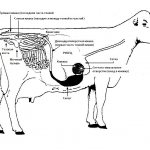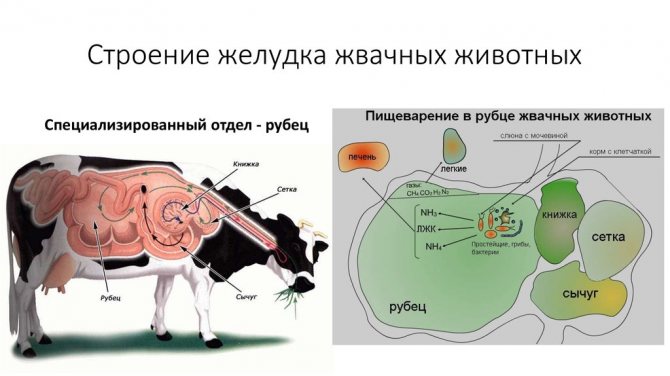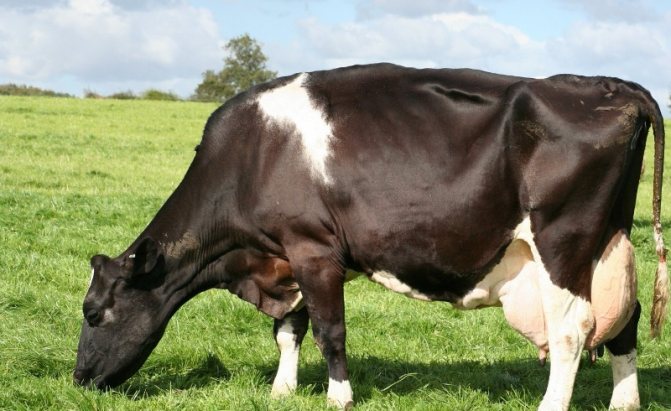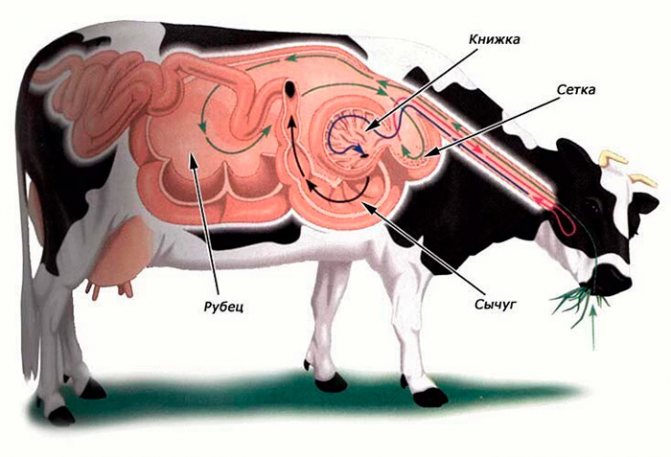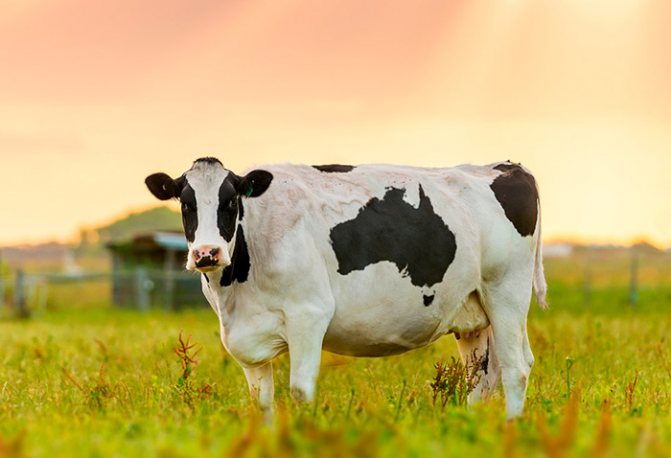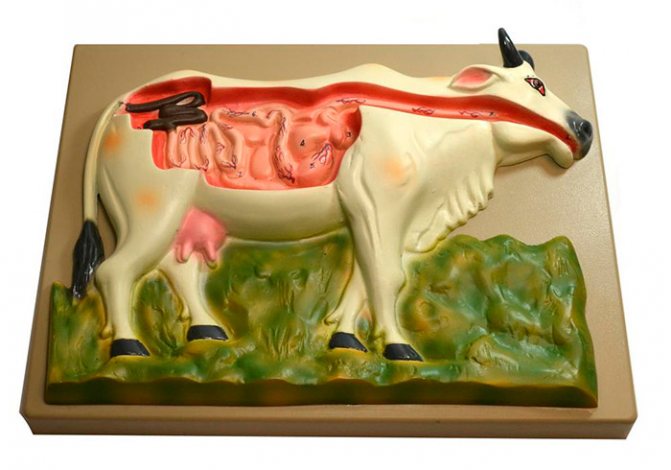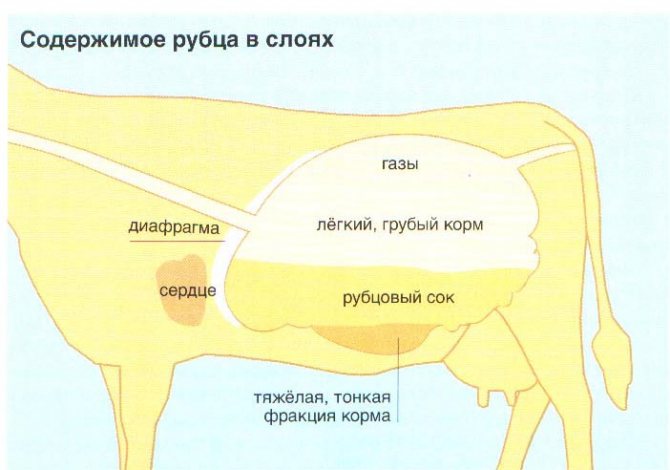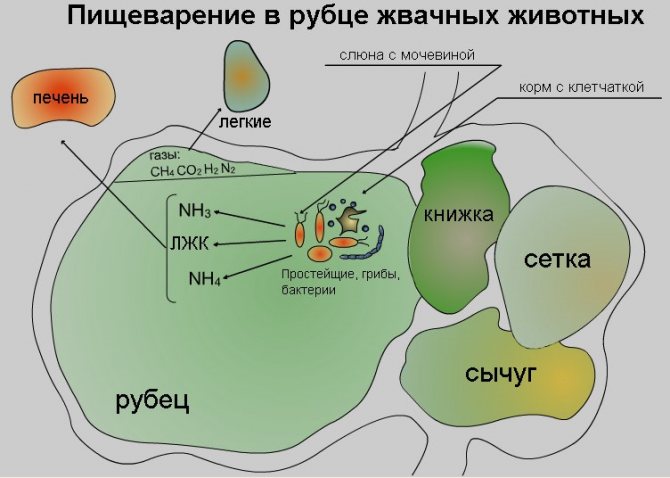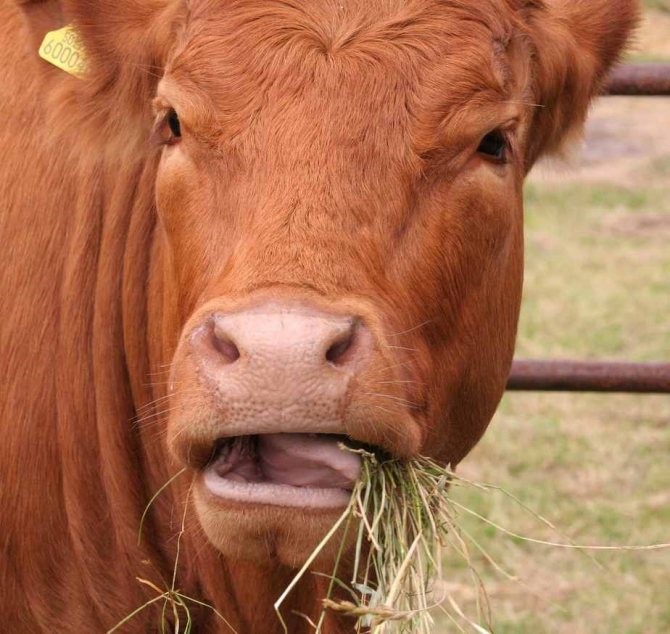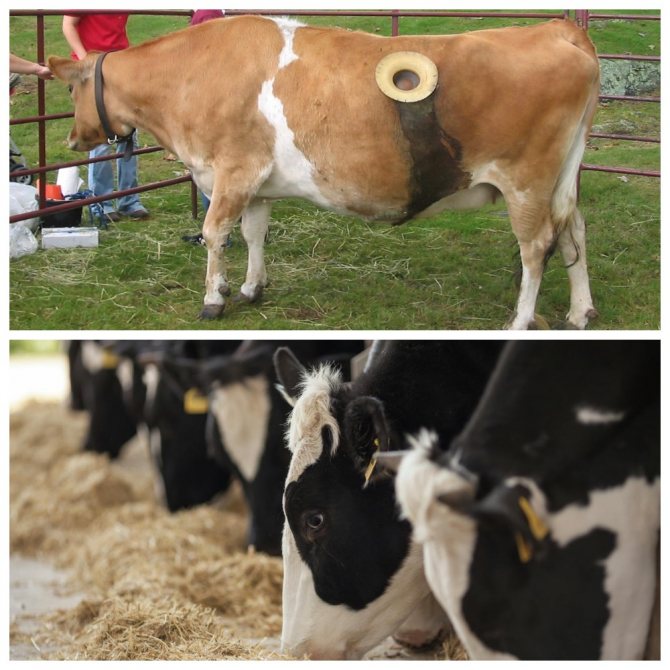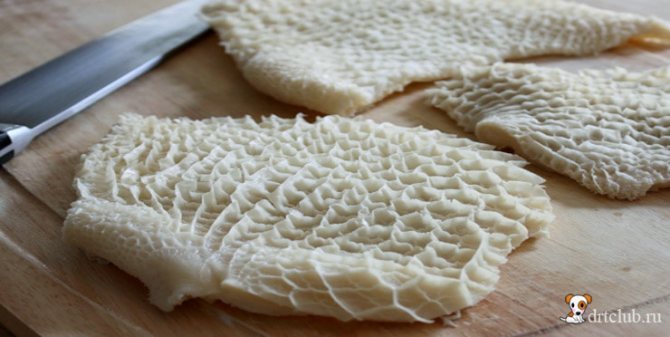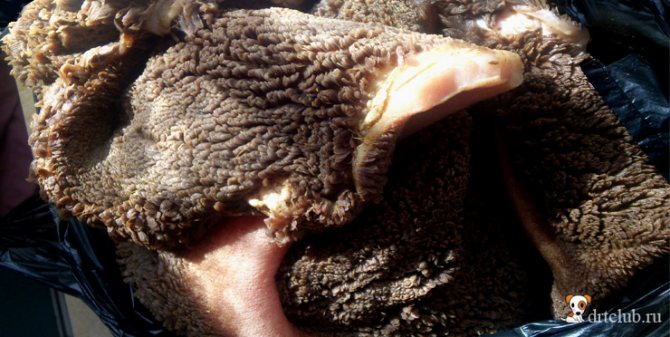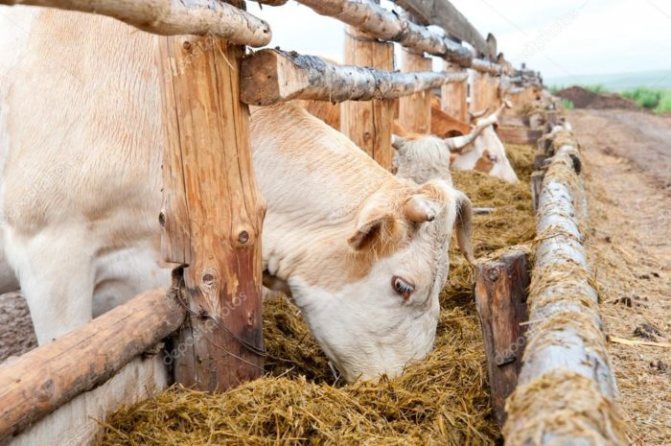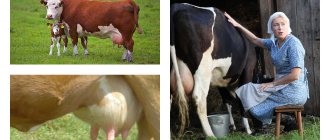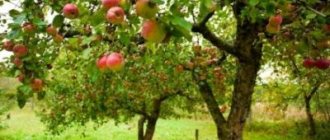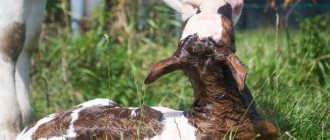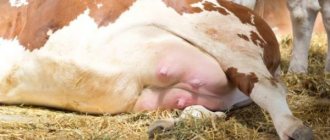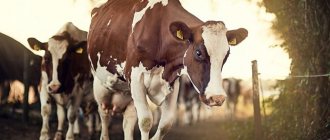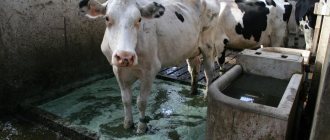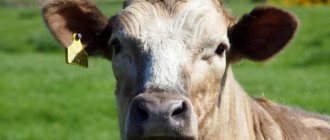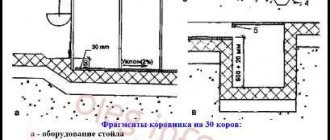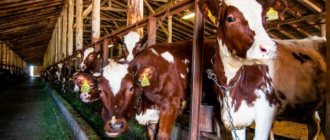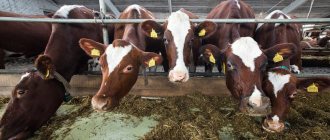Cow digestive system
The peculiarity of cattle digestion is the constant chewing of the so-called "gum" by these animals. They swallow the food they consume, practically without crushing it. After preliminary enzymatic treatment, the food mass moistened with gastric juice and saliva returns to the oral cavity by regurgitation. The cow begins to diligently chew the forage mass and grind it for re-swallowing.
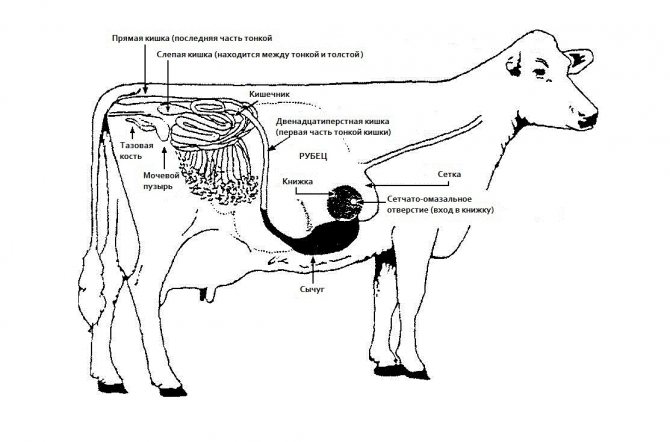
The digestive system of a cow consists of the following sections:
- Oral cavity. It is represented by the outer lips, two rows of teeth and a muscular tongue. Responsible for the primary capture of forage masses, their crushing and swallowing.
- Esophagus. A connecting channel for transporting food masses between the pharyngeal cavity and the stomach. Its length is about 0.5 meters.
- Stomach. A complex four-chamber system that grinds the swallowed food, moisturizes it, breaks it down and conducts it further along the digestive tract.
- Small intestine. It is conventionally divided into duodenal, skinny and iliac areas. Here fodder masses are processed with bile and gastric juices, fats and partially proteins are broken down.
- Colon. Responsible for the final fermentation of the feed, the breakdown of proteins and the formation of feces. A large number of beneficial bacteria live here.
Important! Feeding pregnant queens can lead not only to diseases of the gastrointestinal tract, but also to abortion. Make sure that animals do not get food with high acidity and be sure to warm up the water before pouring it into the drinkers.
Abomasum
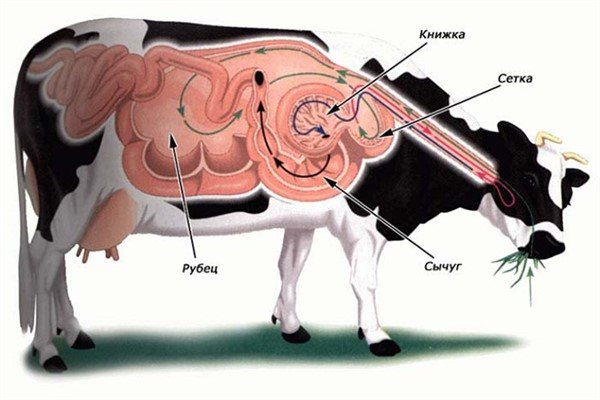

The last of the stomachs of ruminants is similar in structure to other types of mammalian stomachs. It contains a sufficient number of glands that secrete gastric juice. Muscle tissue is formed from longitudinal rings, and the walls are covered with an epithelium containing cardinal and pyloric glands.
Important! The functions of the abomasum are large. Its size is about 14 liters. The food lump that enters the last section of the stomach undergoes final digestion.
The total volume of the stomach of an adult cow is about 145-200 liters.
The structure of the stomach of a cow
Due to its complex structure, the stomach occupies the predominant part of the abdominal cavity. In it, the food is processed with enzymes, rubbed by the muscle walls and broken down with the help of gastric juice with an acidic pH.
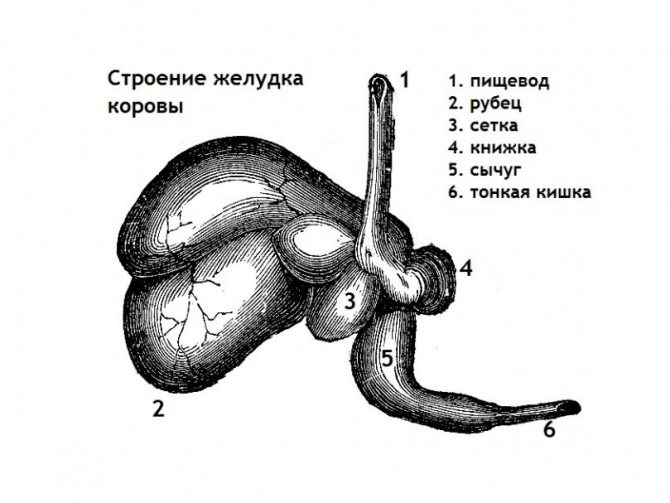

Which side of the cow's stomach and what is it called?
This digestive organ is located in the central and left parts of the cow's peritoneum. Many are interested in how much a cow has a chamber stomach. It consists of one true stomach, called the abomasum, and three auxiliary proventricles - a scar, a ridge and a mesh.
Stomach sections of a cow
Each department has its own functional purpose, which is carried out due to the peculiarities of its structure.
Scar
It has a colossal capacity - in adults, the volume of this section reaches 200 liters. It is located in the left side of the abdominal cavity and partially occupies the right side with the center at the level of the 6th rib. The rumen contains a large amount of beneficial microflora, which is responsible for the primary processing of swallowed feed masses.The total mass of microorganisms reaches 4 kilograms. They synthesize protein compounds that compensate for the lack of animal food in the cow's diet.
Did you know? Since 2020, and today, the Holstein-Friesian cow is considered the heaviest cow in the world.
Burenkanamed Blossom weighs more than 1200 kg, her height at the withers reaches 190 cm. Mistress Blossom, American Patty Henson from Illinois, keeps her pet as a pet. Neither milk nor the Blossom litter is able to give due to congenital barrenness.
The main longitudinal muscle walls of the scar are lined with thin circular muscle tissue and mucous membrane, which is covered with rough papillae. The papillae up to 10 cm long increase the absorption of nutrients and create a comfortable environment for the existence of microorganisms. The rumen is divided by a special chute into two muscle sacs, in which the feed is mixed, starch and sugars are fermented, and the primary breakdown of fiber.
Grid
This part is almost 20 times smaller than the scar - its maximum volume is 10 liters. It is located in the upper part of the scar and, when filled, touches the diaphragm. The grid is responsible for separating the feed into solid and liquid fractions. The solid is returned from the mesh for re-grinding, and the liquid passes to the next section of the intestine.
Book
The third stomach of the cow is located on the right side of the sternum at the 7th rib. The inner part of the book is lined with folded epithelium, which draws in food between the folds and grinds it. This is where water is absorbed and the final breakdown of fiber occurs.
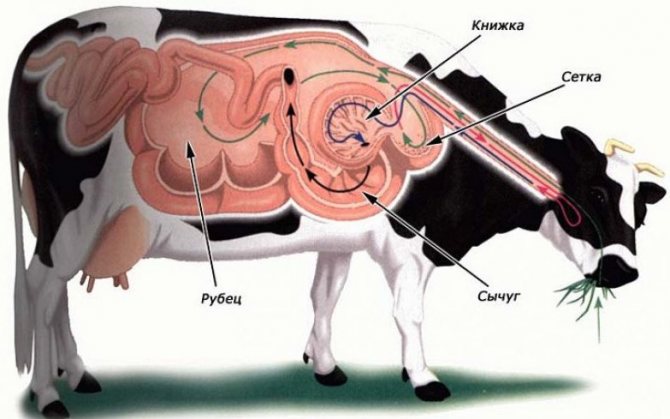

Abomasum
A true bovine stomach that secretes gastric juice, which is composed of free water, enzymes and acids. The volume of the abomasum reaches 15 liters, it is at the level of 11 ribs of the sternum. In the first few weeks after birth, calves digest dairy food exclusively through rennet. Then the proventricles open, an eructation reflex appears, and the young begin to eat solid food.
Important! Up to three weeks of age inclusively, it is forbidden to feed calves of plant origin. Solid food will not be able to digest properly and will begin to ferment in the abomasum.
From which part of the cow's stomach does food burp?
For the eructation typical of ruminants, the mesh is responsible, which returns the swallowed whole food into the oral cavity. The intensity of its contractions depends on the size of the feed particles, the feeding scheme, the age of the animal and its physiological state.
Book
The book is the third gastric section of cattle, which is connected to the mesh with a special gutter. Because of the thin partitions that resemble book pages, the department got its name.
Only thoroughly chewed food enters this part of the cow's digestion, which here begins to ferment and decompose under the action of bacteria.
Due to this system, the animal can assimilate the maximum amount of fiber from the food eaten.
In the book, mineral compounds and liquid are absorbed into the blood of a cattle. Only five percent of the total amount of consumed grass goes to the third section of the stomach, which is associated with complex processing processes.
The inner surface is expelled by folds, between which the food lump falls, and then the process of dehydration occurs.
In addition to moisture, mineral components are absorbed in the book.
Cow stomach pathologies
Poor quality feed, unfavorable living conditions and a disturbed feeding regime provoke disruptions in the work of the digestive tract of cattle. For livestock to be healthy and herd productivity to be high, it is necessary to understand the existing pathologies and know how to get rid of them.
Bloating
Also known as tympania, it is characterized by intense gas formation.It occurs due to a sharp change in diet, grazing in wet meadows with legumes, blockages of the esophagus. Tympania symptoms are:
- refusal to eat;
- bloating of the peritoneum;
- violation of the ruminant reflex;
- anxiety;
- shortness of breath, accelerated pulse;
- blanching of mucous membranes, nasal mirror.
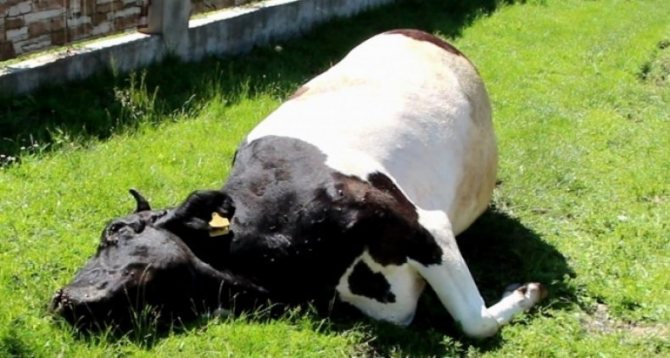

Depending on the cause of the bloating, there are various ways to deal with this problem:
- If the cause of tympania is a blockage of the esophagus, it is necessary to push the body stuck in the intestine with a thin flexible probe. An effective method of starting the stomach is massaging the area of the hungry fossa with a clenched fist. The animal must constantly move at a fast pace - urge it on, do not let it lie down.
- Excessive gas formation is often provoked by an imbalance in the microflora. Medicines such as "Tympanol", activated carbon, magnesia help to cope with this problem.
- An extreme method of getting rid of bloating is considered to puncture the abdominal wall and stomach wall with a trocar, a sharp surgical instrument, and then release gases from the abdominal cavity.
Did you know? The average height of a cow at the withers ranges from 130 cm. In the Indian state of Kerali, there is a cow whose height is far from recognized standards. Baby Vechur weighs only 72 kilograms, her height at the withers is 61 cm, which is 8 cm less than the previous record. The owners of a miniature cow are very proud of their unusual pet, since in 2020 their pet was included in the Guinness Book of Records.
Stop
A frequent cause of this pathology is a violation of the diet and an illiterate diet. Digestion is stopped by an excess of concentrated feed, rotten straw and hay, sour pulp and vinasse. This problem also arises when the esophagus is blocked. The symptoms of a stop are lethargy, apathy, and lack of chewing gum. If you press your palm on the hungry fossa, then you will not be able to feel the pulsation of the stomach.
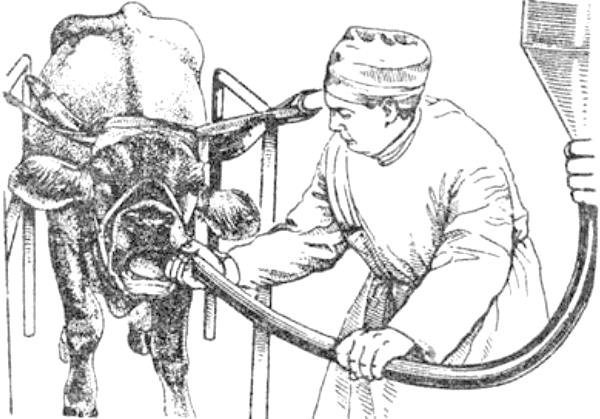

The following remedies are used to kick-start the digestion of a cow:
- daily starvation diet with further balanced nutrition;
- hellebore tincture;
- mechanical washing of the scar;
- a mixture of vodka or saline with vegetable oil;
- intensive massage of the stomach.
Injury
Since ruminants seize and swallow feed without feeling it, there is a high risk of foreign objects entering the feed mass. Foreign bodies such as wire, nails, sharp stones can damage the walls of the stomach and intestines, or get stuck in their mucous membranes. Injury to the walls of the stomach is often through, and neighboring organs - the liver, heart, spleen - are at risk of damage.
The symptoms of this disease are:
- anxiety in the animal, loss of appetite;
- stretching the neck up and forward in an attempt to swallow;
- rounding the back;
- the appearance of blood in the feces;
- constant low-grade fever;
- pain reflex when pressing on the sternum area.
This is the most difficult pathology to cure. Metallic foreign objects are usually removed with a magnetic probe, other foreign bodies are surgically removed. If the treatment is unsuccessful, the animal is sent to slaughter.
Important! If there is a foreign object in the intestine, it is necessary to immobilize the animal. In an attempt to relieve discomfort, the cow may push the foreign body further or pierce the intestinal wall with it.
Blockage
This disease arises as a result of clogging the book with poor-quality feed with grain waste, sand, dirt. A diet high in bran and concentrates will do the same. Symptoms are similar to stopping; these pathologies can be distinguished through a puncture of the stomach with a thin needle. When a blockage occurs, the needle will enter slowly and with effort.
The only way to get rid of the blockage is to flush the intestines.This can be done with a 10% NaCl solution. It is also allowed to use hellebore tincture, sunflower oil, moonshine.
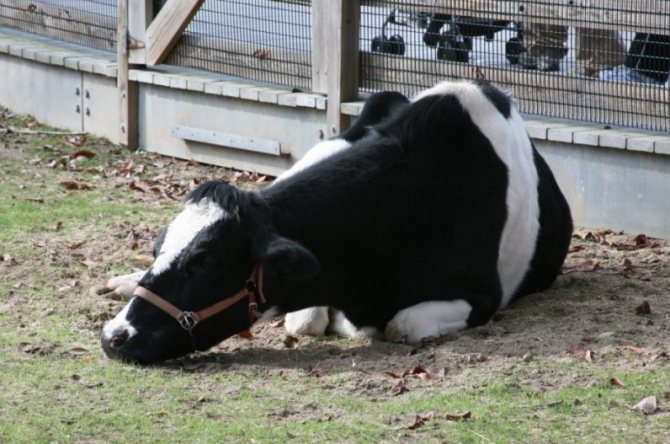

The digestive system of the cow is complex and designed for the constant intake of fiber-rich feed. All parts of the cow's stomach function harmoniously, their normal work depends on the health of each individual part. Provide your herd with quality feed and seek veterinary care in time to keep your animals productive.
Home treatment
Folk remedies can start the stomach using warm water with infused yeast. Next, diluted alcohol and sugar are poured into the prepared container. The resulting composition must be at least 1 liter.
Once every 12 hours, a similar infusion is poured into the throat of a cow for several days. Tympania, or bloating, can occur due to improper feeding.
It is necessary to distinguish bloating from blockages, as they require a completely different approach to treatment. If the body has become due to swelling, you can not hesitate. It is necessary to stop fermentation processes and restore peristalsis as soon as possible, and also be sure to remove accumulated gases from the rumen and organ mesh.
After calving, cows may have problems with stool and fermentation processes in the body. It is necessary to observe a specialist in order to control the process and provide timely assistance if the stomach becomes.
Roll
- Time: 13 hours 30 minutes.
- Servings Per Container: 8 Persons.
- Calorie content: 127 kcal per 100 g.
- Purpose: appetizer, main course.
- Cuisine: international.
- Difficulty: medium.
Juicy beef tripe roll is a real culinary masterpiece that can easily surprise even sophisticated gourmets. Trebukha requires a long preparation, so the preparation of an original appetizer or main dish for a special occasion should be started about a day before the celebration. You can add greens, carrots, allspice to the filling. The offal roll will acquire a beautiful golden crust and will become even more appetizing if you lightly fry it in a pan with aromatic garlic oil. On the basis of a rich broth, you can prepare sauce, soup, and other dishes.
Ingredients:
- beef tripe - 510 g;
- tomatoes - 85 g;
- onions - 115 g;
- cloves to taste;
- fat - 55 g;
- potatoes - 60 g;
- garlic - 3 teeth.;
- bay leaf - 3 pcs.;
- ground black pepper - to taste;
- allspice - to taste;
- salt to taste.
Cooking method:
- Peel the beef offal, immerse it in a container with cold water. Leave on for 6 hours.
- Remove, scald with boiling water.
- Using a knife, clean off the remnants of the mucous membrane of the offal. Rinse.
- Cover the scar with water, add salt.
- Change the water after 2 hours. Cook for 3 hours over low heat.
- Place on a baking sheet or tray. Leave to cool at room temperature.
- Peel the potatoes.
- Cut the bacon into slices or cubes, cut off the skin if desired.
- Spread the cooled offal on the work surface. The edges can be trimmed to add tripe to the filling and give the future roll a regular rectangular shape.
- Season with black pepper and salt.
- Put the filling - bacon, grated garlic.
- Form a roll, tie with a strong thread.
- Transfer the offal to a large saucepan.
- Cover with cold water. Add diced onions, potatoes, chopped tomatoes, cloves, allspice, bay leaf. Add white pepper, your favorite roots, if desired.
- Simmer for 2 hours.
- Cool down. Gently pry off and remove the threads.
- A roll of beef offal is immediately cut into portions or left for an hour so that it “grabs” and seals all the juices.
- Serve the offal platter with a side dish such as green peas.
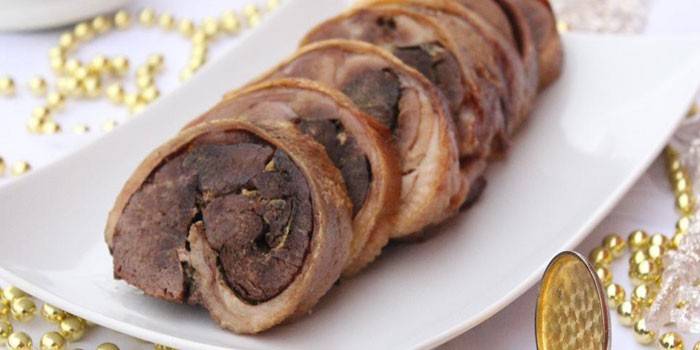

Feeding features
For the first time, a puppy can receive a serving as early as 6 months, but remember that this is a rather heavy product, so you should introduce it gradually, otherwise you can get indigestion and diarrhea. After the animal gets stronger and gets used, you can gradually increase the portion.
Basic nutritional guidelines are the same as for other organ meats:
- You should not completely replace meat with them., since the puppy will not have enough calories, but there will be an excess of some substances, which is also harmful. An oversupply of food will be shown in the form of diarrhea and nausea.
- Don't put your dog on a scar diet., replace only one of the daily feedings.
- Veterinarians advise to observe the same frequency as in the case of other offal, that is, feed the pieces to the dog 2-3 times a week.
- Calculate your serving size correctly, it corresponds to meat, that is, approximately 10 gr. per 1 kg of live weight.
Most dogs perceive the stomach of a cow as a delicacy, and the cheapness and availability make it much easier to keep even large animals.
How to cook and what you can cook
Most often, you can find industrially processed beef tripe on sale. How is it cleared?
- The rumen is shaken, then rinsed in warm enough water;
- Then the product is put into an automatic drum, where it is treated with steam and rinsed with hot water (which is on the verge of boiling). At the same time, in this drum, the scar loses its upper layer - in the lower part of the apparatus there is a disc with ribs, which trims during rotation. Processing takes approximately thirty minutes.
Beef tripe dishes
Hearty offal dishes are not only healthy, but also very tasty. Beef tripe is pre-peeled and cooked until cooked with your favorite spices. Then it is cut into cubes or strips, fried with vegetables, stewed in a slow cooker, added to roasts, goulash and other meat dishes for texture. The rich broth is used to prepare nutritious, warming soups with pepper and herbs. Tripe is added to savory pies, baked in clay pots under a layer of cheese or unleavened dough. The offal is used as the basis for a sumptuous holiday roll.
Bruises
Contusion - mechanical damage to tissues while maintaining the integrity of the skin due to blows with blunt objects, hooves, moving mechanisms, during transportation (see Fig. 29). With severe bruises, inflammation of the surrounding tissues and bone fractures are possible.
A hot, painful swelling appears at the site of injury. The outer covers of the bruised area for 2-3 days become blue-black, then green-yellow. With severe crush injuries, aseptic fever is possible.
The animals are given rest, the skin is smeared with a 5% alcohol solution of iodine or an aqueous solution of potassium permanganate. With severe bruises, to prevent the development of pathological processes in the tendons and joints in the 1st day, cold and astringents, pressing bandages, compresses are prescribed. The veterinarian will prescribe special treatment depending on the indication.
Prevention consists in observing the rules and norms for keeping animals by sex and age groups, observing the rules for transporting and fencing working mechanisms.
Price
Beef tripe is very inexpensive. The price of an unrefined product ranges from 70 to 90 rubles per kilogram. You can buy it at any grocery market where imported meat is sold.
However, it so happens that dog breeders, looking around the counters with a glance, do not find a scar and leave. And in vain. After all, a scar is a rather specific product with a peculiar look and smell, which is simply not laid out on the counter. You just need to ask the seller about its availability. Then the butcher simply goes to the back room, where he will cut off as much scar as you ask.This, at least, is done where I buy it.
For example, if you are in St. Petersburg, you can buy a tripe at the market located on Balkan Square in Kupchino. In addition, there you can also buy beef trachea, tails and other delicious food.
But of course, this is not the only place where tripe is sold. Naturally, it can be found in other retail outlets in different cities.
Wounds
A wound is an open mechanical damage to the skin, mucous membrane, often deep-lying tissues and organs as a result of violation of the zoo-hygienic rules for keeping livestock, littering of the territory of farms, pastures (protruding nails, hooks, pieces of metal, wood, glass, inventory, etc.).
The wound is characterized by gaping, bleeding, and pain. Clinical signs depend on the type of wounding object, body region, depth, direction of injury.
To prevent microbial contamination, the skin around the wound is lubricated with a 5% iodine solution and, if possible, hair is removed. Bleeding must be stopped with a tourniquet placed above the wound. In the presence of a foreign body, it is removed or the dead tissue is excised or the injured site is drained with the help of hypertonic solutions of medium salts (sodium bicarbonate, magnesium sulfate, calcium chloride, sodium sulfate, etc.) of novocaine-antibiotic solutions, Vishnevsky liniment.
In case of contamination with anaerobes, putrefactive infection, the wound is irrigated with a solution of potassium permanganate heated to 40 ° C, hydrogen peroxide, chloracide or 2% chloramine solution, then a bandage is applied.
We suggest that you familiarize yourself with: Diet for a cat to a bowl for health
Beneficial features
The energy value of beef tripe is 97 kcal per 100 grams of product. Trebuha contains zinc, therefore, it reduces the risk of cancer, prevents fetal neural tube defects in pregnant women, strengthens the immune system and normalizes blood clotting. The by-product improves the condition of the skin and thyroid gland, reduces the level of homocysteine, slows down the aging process, and has a beneficial effect on the digestive system, vision, and smell. The product is rich in proteins that support muscle tone and participate in their structure, help to lose excess weight.
Biologically significant macronutrients and microelements of beef rumen
| Nutrient | Quantity in 100 g of product |
| Potassium | 325 mg |
| Sulfur | 148 mg |
| Phosphorus | 84 mg |
| Sodium | 65 mg |
| Calcium | 15 mg |
| Magnesium | 14 mg |
| Iron | 3 mg |
| Niacin | 1.6 mg |
| Vitamin PP | 1.6 mg |
| Zinc | 1.45 mg |
| Vitamin B2 (riboflavin) | 0.15 mg |
| Vitamin B1 (thiamin) | 0.05 mg |
| Iodine | 7 mcg |

